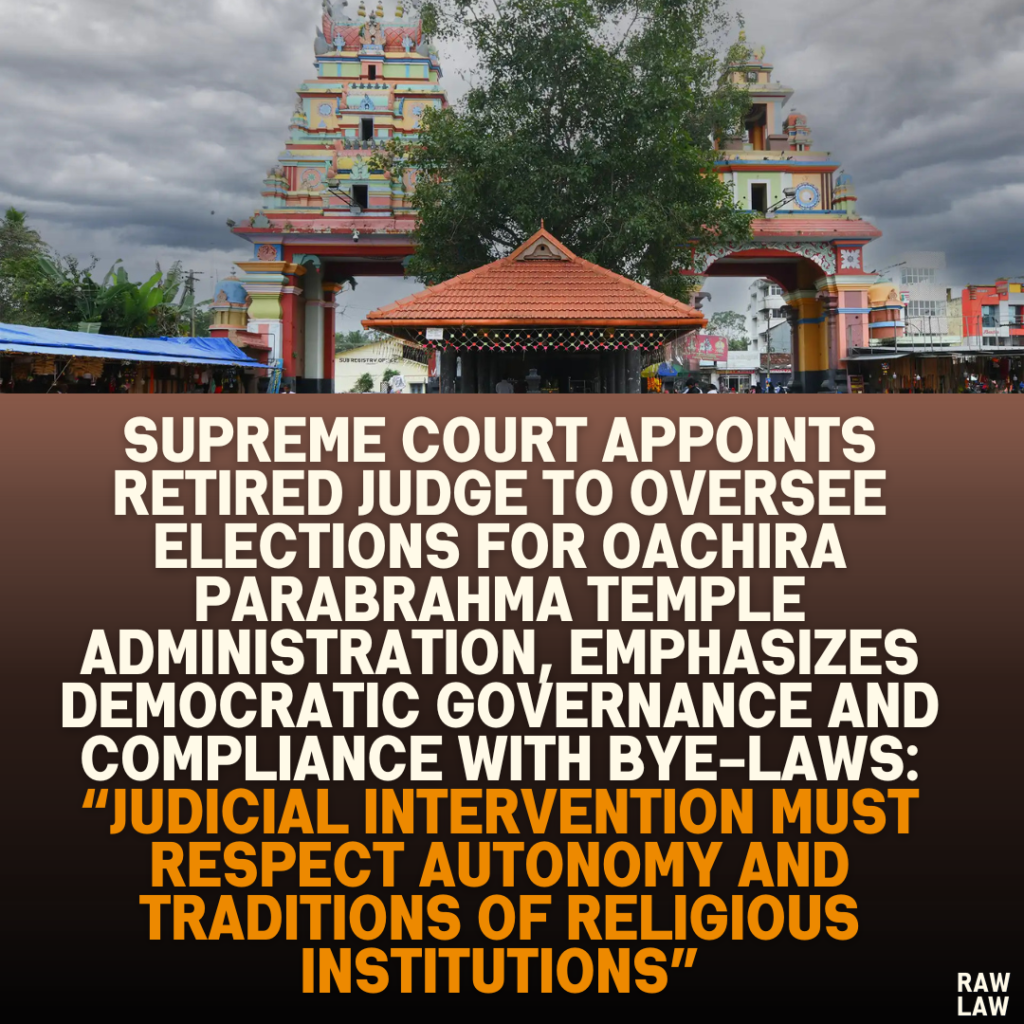Court’s Decision:
The Supreme Court modified the orders of the Kerala High Court concerning the administration of the Oachira Parabrahma Temple. The Court appointed Hon’ble Mr. Justice K. Ramakrishnan (Retd.) as the new Administrative Head/Administrator to conduct elections for the temple’s management. It directed that these elections be completed in strict compliance with the temple’s bye-laws within four months. The new Administrative Head will oversee the transition until the elected committee takes charge. Additionally, the trial court was instructed to expedite the framing of a scheme for the temple’s administration.
Facts:
The Oachira Parabrahma Temple, located in Kerala, is unique in its form as it lacks a consecrated idol, deity, or sanctum sanctorum. It administers various institutions, including a super-specialty hospital, a nursing college, and a school, under a three-tier elected committee system governed by its bye-laws.
In 2006, devotees filed a suit (OS No. 1/2006) before the District Court seeking the framing of a scheme for the temple’s administration. In 2010, the trial court passed a preliminary decree directing the formulation of a scheme while permitting the administration to continue as per the existing bye-laws.
During the pendency of the suit, a Regular First Appeal (RFA No. 562/2010) was filed by hereditary trustees seeking safeguards for their roles and rights in the proposed scheme. The High Court appointed an Administrative Head and an unelected committee to manage the temple, removing the elected Executive Committee. This decision led to appeals before the Supreme Court.
Issues:
- Whether the High Court, after disposing of the Regular First Appeal, had jurisdiction to entertain subsequent interlocutory applications and pass the impugned orders.
- Whether the High Court was justified in removing the elected Executive Committee and appointing an unelected committee in its place.
Petitioner’s Arguments:
- The High Court became functus officio (lacking jurisdiction) after disposing of the RFA and therefore could not entertain subsequent applications or pass the second impugned order.
- The removal of the elected Executive Committee and the appointment of an unelected five-member committee violated the temple’s bye-laws and disrupted long-standing practices.
- The appointed Administrative Head acted arbitrarily, issuing orders without consulting the elected representatives and failing to visit the temple premises.
Respondent’s Arguments:
- The steps taken by the High Court, including the appointment of an Administrative Head and unelected committee, were necessary to maintain the smooth administration of the temple until elections were conducted and a scheme was framed.
- The measures were temporary and aimed at ensuring transparency and order in temple management.
Analysis of the Law:
The Supreme Court reviewed the temple’s bye-laws, which stipulate that elected bodies serve a five-year term. It noted that the last election occurred in May 2017, and no subsequent elections were held, creating a governance vacuum. The Court emphasized the need for procedural compliance and democratic governance in religious institutions. It observed that the High Court’s orders, while intended to address administrative challenges, contravened the temple’s bye-laws and democratic processes by appointing an unelected committee.
The Court reiterated that High Courts should exercise supervisory jurisdiction within defined limits, especially in matters concerning religious institutions where autonomy and traditions must be respected.
Precedent Analysis:
The judgment aligns with established legal principles that safeguard the autonomy of religious institutions while ensuring compliance with statutory norms. The Court underscored the need to balance judicial intervention with respect for traditional governance structures.
Court’s Reasoning:
The Court acknowledged the disputes arising from the High Court’s orders and the grievances about the functioning of the Administrative Head. It emphasized that the appointment of an Administrative Head is a temporary measure, with the ultimate goal being the restoration of democratic functioning through elections.
The Court also considered the unique nature of the temple and its role in running public institutions like hospitals and colleges. It recognized the importance of maintaining continuity in temple administration while preparing for a fair election process.
Conclusion:
The Supreme Court passed the following directions:
- Appointed Hon’ble Mr. Justice K. Ramakrishnan (Retd.) as the Administrative Head/Administrator to oversee and conduct elections for the temple’s administration in accordance with its bye-laws.
- Directed the new Administrative Head to finalize the voters’ list and complete the election process within four months.
- Allowed the Administrative Head to appoint two assistants (a retired District Judge and a legal professional) for smooth conduct of elections, specifying their remuneration.
- Instructed the trial court to expedite the framing of the scheme and final decree proceedings, allowing all parties to raise contentions during these proceedings.
- Terminated the role of the previously appointed Administrative Head and Advocate Commissioner, directing them to hand over responsibilities to the new Administrator.
The Court ordered the continuation of existing arrangements for temple administration until elections are completed and the newly elected committee assumes charge.
Implications:
This judgment underscores the importance of democratic governance in religious institutions while balancing the need for interim measures to address administrative challenges. It highlights the judiciary’s role in ensuring transparency, compliance with governing statutes, and respect for traditional practices. The decision provides a framework for managing disputes in similar cases, emphasizing that judicial intervention should be limited to facilitating fair and lawful processes.
